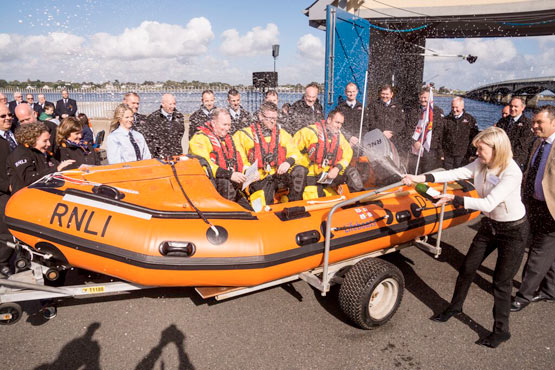#RNLI - At a special ceremony held yesterday (Saturday 26 September), Wexford RNLI officially named its new D class lifeboat, Alfred William Newman, at its lifeboat station in the town, adjacent to Wexford Bridge and the Quays.
As previously reported on Afloat.ie, the lifeboat, which went on service on the 25 June this year, was funded by the late Alfred William Newman from Birmingham who, through a bequest in his will, provided the D class lifeboat to enable crews to continue Wexford RNLI’s lifesaving service.
Welcoming guests at the ceremony Wexford RNLI lifeboat operations manager Nick Bowie said the naming ceremony and service of dedication was a special occasion in the history of the Wexford lifeboat station.
He also welcomed members of the Booth family, who funded Wexford RNLI’s last lifeboat in memory of their beloved son and brother Philip. During its time on service, the Philip Robert Booth launched 112 times, saved eight lives and rescued 86 people.
The honour of naming the new lifeboat went to Yvonne Shields, chief executive at the Commissioners of Irish Lights, an organisation which has for many years enjoyed strong links with the RNLI.
Speaking at the event, she said Irish Lights had a deep admiration for the RNLI and the wonderful work the charity did around the coast.
"It is a remarkable organisation powered by a remarkable network of volunteers, who together are hugely dedicated and committed to the safety of all. At Irish Lights our role is also focused safety at sea through the provision of aids to navigation to ensure safety passage for all.
"We regard ourselves and the RNLI as part of the same family of organisations dedicated to the safety and wellbeing of mariners around the coast and indeed there are many Irish Lights people directly involved in the RNLI. This close and heartfelt relationship between our two organisations is why I was delighted to be asked to participate in today’s ceremony."
RNLI Irish Council member Niamh McCutcheon accepted the lifeboat on behalf of the RNLI before handing her over into the care of Wexford Lifeboat Station.
McCutcheon said the demand for the lifeboat service showed no sign of slowing down. "Here in Wexford over the past five years, the volunteer lifeboat crew have launched on average 11 times each year, rescuing a total of 47 people," she said.
"That is an incredible achievement, and I would like to pay a particular tribute to every crew member, shore crew, station manager and fundraiser who has made every one of those launches possible. Each and every one of you had a vital role in that rescue."
Since the new lifeboat went on service in Wexford there have been six callouts and many training exercises.
Accepting the new lifeboat, Bowie said: "Part of my job is to authorise her launch when requested. Through the Irish Coast Guard I have the volunteers paged, asking them to get down to the station as quick as possible and prepare for a launch.
"When they arrive, and get kitted up, and head out to sea, I’ll have peace of mind because I know this lifeboat will help to keep them safe, as they save others. So, on behalf of all the station volunteers, I would like to thank the donors and their family. Your generosity has given Wexford Town a lifesaver."
A crowd of well-wishers turned up to see the lifeboat officially named, with a bottle of champagne poured over the side of the boat before it launched at the end of the ceremony for a demonstration.
Also among the platform party were Cllr Ger Carty, Mayor of Wexford, who opened proceedings; Owen Medland, RNLI divisional operations manager, who described the lifeboat and her capabilities during the ceremony; Jack Higginbotham, lifeboat boathouse manager, who delivered the vote of thanks; and Sophie Gulliver, daughter of volunteer crew member Simon Gulliver.
Father Aodhan Marken and Canon Arthur Minion lead the Service of Dedication, with music provided by the Wexford Male Voice Choir.































































